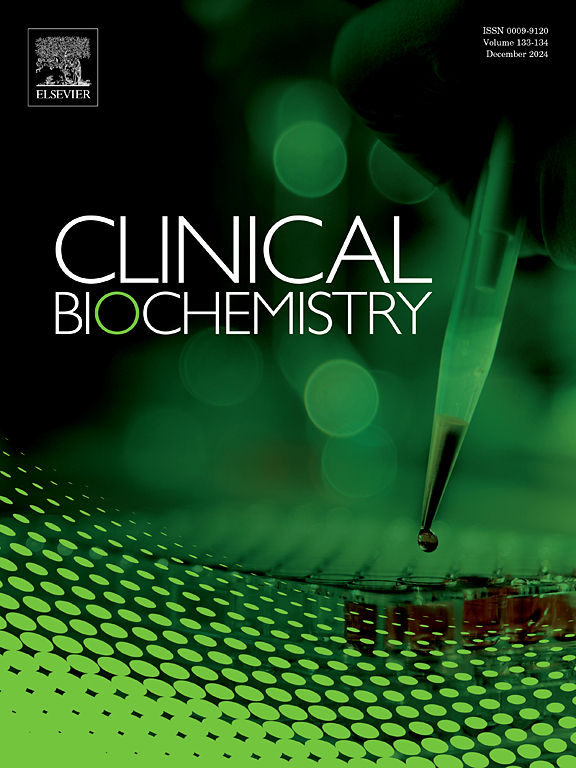通过餐后血糖通路将妊娠期RBP4与骨吸收联系起来:横断面中介分析
IF 2.1
3区 医学
Q2 MEDICAL LABORATORY TECHNOLOGY
引用次数: 0
摘要
背景Retinol结合蛋白4(RBP4)是一种与葡萄糖代谢有关的关键脂肪因子,在妊娠期间升高并与妊娠糖尿病(GDM)有关。然而,它与妊娠期骨吸收的关系仍不清楚。本研究旨在调查RBP4与骨吸收(通过I型胶原β-C端端肽[β-CTX]测量)之间的关系,并探索涉及妊娠期血糖失调的潜在中介途径。方法 在这项横断面研究中,我们分析了孕妇的血清 RBP4、β-CTX、血糖指标(空腹血糖、1 小时 [GLU1h] 葡萄糖、负荷后 2 小时 [GLU2h] 葡萄糖)、胰岛素抵抗指数(IR)和 GDM 状态。结果经调整孕妇年龄、孕龄和体重指数后,RBP4 每增加 1 毫克/升与β-CTX 上升 10.7 纳克/升相关(解释了 7% 的方差)。单中介模型显示,GLU1h 和 GLU2h 单独占 RBP4-β-CTX 关联的约 50%(间接效应分别为 5.33 和 5.40)。在序列中介中,合并血糖途径中介了总关联的 0.502(Indirect_All = 5.42),而单个途径不显著,这表明餐后阶段之间可能存在相互作用。值得注意的是,GDM 状态和 IR 没有显示出中介作用,这可能反映了二分法诊断阈值和妊娠适应性胰岛素抵抗的局限性。这些发现强调了对 RBP4 升高(即使低于 GDM 临界值)的妇女进行连续血糖监测和有针对性干预的重要性,以应对潜在的骨骼健康风险。本文章由计算机程序翻译,如有差异,请以英文原文为准。
Linking gestational RBP4 to bone resorption via postprandial glycemic pathways: A cross-sectional mediation analysis
Background
Retinol-binding protein 4 (RBP4), a key adipokine associated with glucose metabolism, is elevated during pregnancy and linked to gestational diabetes mellitus (GDM). However, its relationship with gestational bone resorption remains unclear. This study aimed to investigate the association between RBP4 and bone resorption (measured by β-C-terminal telopeptide of type I collagen [β-CTX]) and explore potential mediation pathways involving glycemic dysregulation in pregnancy.
Methods
In this cross-sectional study, we analyzed serum RBP4, β-CTX, glucose metrics (fasting blood glucose, 1-hour [GLU1h], 2-hour [GLU2h] post-load glucose), insulin resistance indices (IR), and GDM status in pregnant women. Mediation analyses were performed to identify statistical pathways connecting RBP4 and β-CTX.
Results
After adjusting for maternal age, gestational age, and body mass index, each 1 mg/L increase in RBP4 was associated with a 10.7 ng/L rise in β-CTX (explaining 7 % of variance). Single-mediator models indicated that GLU1h and GLU2h independently accounted for approximately 50 % of the RBP4-β-CTX association (indirect effects: 5.33 and 5.40, respectively). In serial mediation, the combined glycemic pathways mediated 0.502 of the total association (Indirect_All = 5.42), while individual paths were non-significant, suggesting potential interplay between postprandial phases. Notably, GDM status and IR showed no mediation, likely reflecting limitations of dichotomous diagnostic thresholds and pregnancy-adapted insulin resistance.
Conclusion
The association between RBP4 and bone resorption in pregnancy is largely linked to dynamic postprandial glucose fluctuations rather than categorical GDM. These findings highlight the importance of continuous glucose monitoring and tailored interventions in women with elevated RBP4, even below GDM thresholds, to address potential bone health risks.
求助全文
通过发布文献求助,成功后即可免费获取论文全文。
去求助
来源期刊

Clinical biochemistry
医学-医学实验技术
CiteScore
5.10
自引率
0.00%
发文量
151
审稿时长
25 days
期刊介绍:
Clinical Biochemistry publishes articles relating to clinical chemistry, molecular biology and genetics, therapeutic drug monitoring and toxicology, laboratory immunology and laboratory medicine in general, with the focus on analytical and clinical investigation of laboratory tests in humans used for diagnosis, prognosis, treatment and therapy, and monitoring of disease.
 求助内容:
求助内容: 应助结果提醒方式:
应助结果提醒方式:


